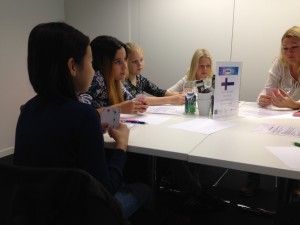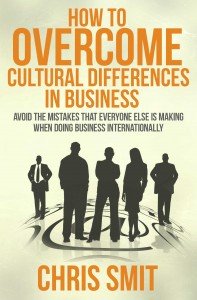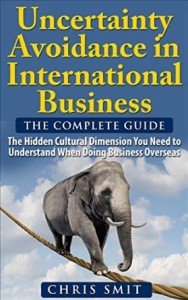Diversity in the Classroom
Several weeks ago I received an email from the Microsoft Innovation Office in Brussels, Belgium. They asked me if I could assist them in explaining cultural differences to a group of children from several European countries; in other words, a lot of diversity in the classroom.
I said yes. And with that came the biggest challenge I have had for a long time.
In this article, I would like to share my experiences with these kids, how I prepared, and by writing this article adding to the little information there is available on the Internet to prepare oneself for real diversity in the classroom. I hope you will find it helpful, insightful, and entertaining.
The Setting
What Microsoft did was the following: They brought together a group of children between the ages of 6 and 16 from different European countries.
Microsoft has developed a game coding platform called Kodu. In every country, there had already been a competition and the kids coming to Brussels were the winners of their respective countries. The countries present were:
- Belgium

- United Kingdom
- Greece
- Estonia
- Latvia
- Finland
- Norway
Norway brought 2 children, while the UK had the biggest delegation with about 7. Each country also had one or two teachers. All except the Belgian delegation were flown into Brussels at the expense of Microsoft to do a final competition for the Kodu Kup (no typo here), of course, enjoy the culture of Belgium/Brussels, and to get to know each other better.
All in all, there were 28 people, students, and teachers combined.
How I Prepared
My first thoughts about this were “How hard can this be?” But then I started thinking a bit deeper and wondering about their ability to understand English. Could they understand something as abstract as a culture? Could I deal with children of that age? I deal with diversity in the classroom, but then with adults, not children.
Plenty of questions that I had to find an answer to. The first one was easy: English. Microsoft assured me that language would not be much of a problem since there would be a teacher present who would be able to translate, if and when necessary.
But then the other challenges remained. So, rather than bombarding them with PowerPoint slide after PowerPoint slide, I opted to play a game with all of them. Students and teachers together. The game I chose was called Barnga (if you’re interested in knowing more about this game, make sure to click the link and read the book description).
One of the main advantages of Barnga is that it is an imaginary card game, with simple rules that pretty much everyone can understand. Plus during the game, the players are not allowed to talk, which helped in overcoming the language barrier.
I prepared a simple PowerPoint presentation to introduce myself, to introduce the concept of culture, and the rules of the card game.
The way I introduced the concept of culture was very simple, using images of different types of food (sushi, pizza, sandwich), and different types of dress that different cultures wear (UK, Thailand, Netherlands).
Diversity in the Classroom: My Try-Out
I  have no experience with working with kids. I work with adults all of the time. Adults can think on an abstract level. And my use of words is tailored to the business world because that’s where my customers are.
have no experience with working with kids. I work with adults all of the time. Adults can think on an abstract level. And my use of words is tailored to the business world because that’s where my customers are.
But… I have children myself. So I decided to ask the principal of my youngest daughter’s school if she would agree to do a try-out. She (the principal) suggested I would work with kids in group 3, which in Belgium where I live, are kids around the age of 8. So I had to explain cultural differences and play a culture game with kids 8 years of age. There wasn’t that much diversity in the classroom there.
On the day of my try-out, there were 54 (!) kids present in the school’s cafeteria/restaurant. Fortunately, I had the help of 5 teachers.
My biggest challenge and that of the teachers turned out to be to keep all those kids quiet, so I could explain what we were about to do. Also during the actual card game, keeping everyone quiet was the most difficult.
Playing the card game itself went smoothly. I had simplified the Barnga rules a bit and had a test read with my youngest daughter. I figured that if she could make sense of the rules (she’s 10), 8-year-olds with a bit of help from a teacher would be able to make sense of it too.
But then came the wrap-up of my introduction and the card game we just played. And this is where I stumbled. I simply could not make the transition from the card game back to the subject of culture. Not with those kids. I simply did not have simple enough words to make the essence of cultural differences clear within the context of the card game we just played.
So in the end, I just called it a day and thanked the kids and the teachers for helping me.
Afterward, a couple of teachers and I sat together to evaluate what had happened and how to improve things. One teacher came up with some good suggestions:
- Group tables with children and give them the name of a country. This makes the situation more real and brings it closer to culture at the same time.
- After the card game, tell a story. A story of a child that moves from one country to another, and how this child has difficulties in adapting to her new environment. This is easier for younger children to relate to than abstract theory. Typically also if there is a lot of diversity in the classroom.
Armed with this experience, and with the tips and feedback, I was ready to do the real thing a week later…
The Actual Event
 The actual event took place in Microsoft’s Innovation Centre in Brussels, Belgium. As I said, there were 28 people in total, all seated at their respective country tables.
The actual event took place in Microsoft’s Innovation Centre in Brussels, Belgium. As I said, there were 28 people in total, all seated at their respective country tables.
The first thing that I noticed was that most of the students spoke English really well. That was promising.
I started doing my introduction of myself, and the concept of culture. With these older kids, I was able to delve into the concept of stereotyping, and we discussed if stereotypes are true or false.
I further explained what culture was, pretty much the same way as I had done with the try-out session.
We then started the card game. There is not much to say about the actual playing of the card game; it simply went smoothly. Whereby, during round two, the confusion hit the tables, as it always does with this Barnga game (for the sake of not giving away the essence of this game, I’m not further elaborating on the how and why’s of this game; if you want more information, please click the link mentioned earlier in this article).
Game Debrief
The debrief of Barnga works in three rounds. Each is accompanied by its own specific question:
- Round 1: “What did you think?“
- Round 2: “What did you feel?“
- Round 3: “What did you do?“
The feedback I got from the students was very comparable to what I normally get when I play this game with adults. Most kids could easily make the connection between this game and cultural differences. When I asked “Which table was the best?“, all of them answered that none was the best, but that they were just different. Just like cultural differences are only differences, and not good or bad.
Wrap-up and Lessons Learned
If you’re doing anything around culture and kids, I have a couple of suggestions for you to consider:
- Under the age of 10 explaining something as abstract as cultural differences is very difficult. Younger kids just don’t see the differences (yet). They are so-called color blind. So work with kids aged 10 and up.
- Keep your groups small. If you want to achieve anything it makes good sense to stick with smaller groups, say max 25. It is easier to manage, and there is more of a possibility of dialogue.
- Play a game. Using Barnga was a (lucky but) good idea. It is much easier to convey an idea like “culture” if you wrap it into something easy to digest like a game, rather than a set of PowerPoint slides.
- Don’t underestimate children. This might be in slight contrast with my first point, but kids 10 & up already have a pretty good grasp of what is going on in the world and the diversity in the classroom.
- Don’t go over 1 1/2 hour duration max. I found that older kids do have a longer span of attention, but still, next time I would want to stick to 1 hour to 1 1/2 hours. Otherwise, you simply lose them.
I thoroughly enjoyed working with these young adults. It was very inspirational and rewarding.
Talking about International Business Schools? Read this article.
Another podcast on diversity In the classroom with kids can be found here.
Share your experiences in explaining cultural differences to children. Let me know your thoughts in the comments below.
Get a Taste of How Chris Presents, Watch his TEDx Talk
 Call Direct: +32476524957
Call Direct: +32476524957
 European Office (Paris) Whatsapp: +32476524957
European Office (Paris) Whatsapp: +32476524957
The Americas (USA; Atlanta, GA; también en Español): +1 678 301 8369
Book Chris Smit as a Speaker
If you're looking for an Engaging, Exciting, and Interactive speaker on the subject of Intercultural Management & Awareness you came to the right place.
Chris has spoken at hundreds of events and to thousands of people on the subject of Cultural Diversity & Cultural Competence.
This is What Others Say About Chris:
- “Very Interactive and Engaging”
- “In little time he knew how to get the audience inspired and connected to his story”
- “His ability to make large groups of participants quickly and adequately aware of the huge impact of cultural differences is excellent”
- “Chris is a dedicated and inspirational professional”
In addition, his presentations can cover specific topics cultural topics, or generally on Cultural differences.
Presentations can vary anywhere from 20 minutes to 2 hours and are given worldwide.
Book Chris now by simply sending an email. Click here to do so.
Read more about what Chris can do for you.
- Percentage of People Rating a Presentation as Excellent 86%
- Rating the Presentation as Practical 89%
- Applicability of Chris' presentation 90%
About Peter van der Lende

Peter has joined forces with Culture Matters.
Because he has years and years of international business development experience joining forces therefore only seemed logical.
Being born and raised in the Netherlands, he has lived in more than 9 countries of which most were in Latin America.
He currently lives in Atlanta, Georgia (USA) with his family.
You can find out more at https://expand360.com/
Or find out what Peter can do for you here.
- 195 Managing Diversity for Growth with Emmanuel Daniel - 14 October 2025
- 194 Leadership and Culture with Adam Malone - 16 September 2025
- 193 Cultural Differences in Sales with Adam O’Connor - 2 September 2025




 Call Direct: +32476524957
Call Direct: +32476524957 European Office (Paris) Whatsapp: +32476524957
European Office (Paris) Whatsapp: +32476524957
I feel your pain. It sounds like you came up with a useful and replicable strategy. I want to just touch upon your comment that kids are “so called color blind.” Color blindness is a very different experience than cultural difference, which can actually refer to groups of people that look very much alike. Kids are not color blind as much as they have not yet (in many cases) formed solid narratives about the value of the difference they perceive. This may be the abstraction that you hit when working with the school kids. It is a difficult bridge to cross without really delving into stereotypes related to color (of humans) and the danger is you embed something that was not there before. So, I think you did the right thing with just finishing up. However, that doesn’t mean that you could not have re-approached that issue with the older kids in the smaller groups. The first step would be to separate cultural difference from color difference. Just doing this – in words – is something kids as young as 5 can understand. For example is someone different because they look different (and this could be color (skin, hair, eyes) or ability difference) or because of the way they dress or talk or the food they eat (getting at more directly cultural activities like language, dress, food, rites of passage). Kids see these differences and “get” them. Oddly, adults tend to see color difference and stop there. They can be moved to consider cultural difference but they have to be able to get around the narratives of color difference that they have internalized. Thanks for a great conversation.
Hi Lesliee,
Thanks for your comment.
I guess you’re right when it comes to the “color blindness” of kids. They ultimately learn the differences when they get older.
Thanks for the tip on how to approach this topic in the future.